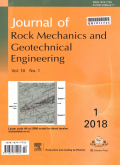- 钛学术文献服务平台 \
- 学术期刊 \
- 基础科学期刊 \
- 天文学、地球科学期刊 \
- 岩石力学与岩土工程学报(英文版)期刊 \
Modification of nanoparticles for the strength enhancing of cement-stabilized dredged sludge
Modification of nanoparticles for the strength enhancing of cement-stabilized dredged sludge
基本信息来源于合作网站,原文需代理用户跳转至来源网站获取
摘要:
This paper investigates the effectiveness of nano-modification on the strength enhancement of cement-stabilized dredged sludge (CDS). Three types of nanoparticles including nano-SiO2 (NS), nano-Al2O3 (NA) and nano-MgO (NM) were used as cement admixtures for dredged sludge stabilization. Effects of single nanoparticle content, mass ratio of composite nanoparticles and curing time on the strength develop-ment of CDS were evaluated via a series of unconfined compressive strength (UCS) tests. The pH evo-lutions of CDS caused by nanoparticles were also examined by a range of pH tests. Furthermore, micro-mechanisms reflecting the strength evolutions were analyzed by performing scanning electron micro-scopy (SEM) and X-ray diffraction (XRD) tests. The results indicated that adding nanoparticles can significantly improve the UCS of CDS. For single nano-modification, the optimum contents of NS, NA and NM were 4%-6%, 6%and 8%, which can increase the 7-and 28-d UCSs of CDS by 38%and 50%, 17%and 35%, 65%and 67%, respectively. Compared with single nano-modification, composite nano-modifications were more effective in improving the strength gain of CDS. The optimum mass ratios of composite nanoparticles, namely NS/NA, NS/NM and NA/NM, were 9/1, 3/7 and 3/7, respectively. Based on the strength growth rate, the composite nanoparticles with NS/NM of 3/7 were highly recommended. The addition of nanoparticles obviously affected the pH evolution of CDS, which was mainly determined by the difference of OH- production and consumption inside nano-modified CDS. The microstructural analysis revealed that C-S-H and C-A-H gels are the main cementitious products, and the addition of nanoparticles can obviously contribute to a denser and more homogenous microstructure of CDS.

推荐文章
Magnetic Influences of Cement Dust on Soil in Industrial Area and Its Environmental Implications
Cement dust
Soil
Magnetic property
Environmental significance
The effect of pH on the sorption of gold nanoparticles on illite
Gold nanoparticles
Illite
Sorption
Charge
Electrostatic interaction
Sand-Cement回填料在工程建设中的应用
CLSM
Sand-Cement回填不需压实进度
内容分析
关键词云
关键词热度
相关文献总数
(/次)
(/年)
文献信息
| 篇名 | Modification of nanoparticles for the strength enhancing of cement-stabilized dredged sludge | ||
| 来源期刊 | 岩石力学与岩土工程学报(英文版) | 学科 | |
| 关键词 | |||
| 年,卷(期) | 2021,(3) | 所属期刊栏目 | |
| 研究方向 | 页码范围 | 694-704 | |
| 页数 | 11页 | 分类号 | |
| 字数 | 语种 | 英文 | |
| DOI | |||
五维指标
引文网络
引文网络
二级参考文献 (27)
共引文献 (7)
参考文献 (33)
节点文献
引证文献 (0)
同被引文献 (0)
二级引证文献 (0)
1978(1)
- 参考文献(0)
- 二级参考文献(1)
2007(1)
- 参考文献(1)
- 二级参考文献(0)
2009(2)
- 参考文献(1)
- 二级参考文献(1)
2010(1)
- 参考文献(0)
- 二级参考文献(1)
2011(5)
- 参考文献(2)
- 二级参考文献(3)
2012(3)
- 参考文献(1)
- 二级参考文献(2)
2013(2)
- 参考文献(1)
- 二级参考文献(1)
2014(5)
- 参考文献(1)
- 二级参考文献(4)
2015(6)
- 参考文献(2)
- 二级参考文献(4)
2016(14)
- 参考文献(5)
- 二级参考文献(9)
2017(7)
- 参考文献(6)
- 二级参考文献(1)
2018(2)
- 参考文献(2)
- 二级参考文献(0)
2019(8)
- 参考文献(8)
- 二级参考文献(0)
2020(3)
- 参考文献(3)
- 二级参考文献(0)
2021(0)
- 参考文献(0)
- 二级参考文献(0)
- 引证文献(0)
- 二级引证文献(0)
引文网络交叉学科
相关学者/机构
期刊影响力
岩石力学与岩土工程学报(英文版)
主办单位:
中国科学院武汉岩土力学所
中国岩石力学与工程学会
武汉大学
出版周期:
双月刊
ISSN:
1674-7755
CN:
42-1801/O3
开本:
大16开
出版地:
湖北省武汉市武昌区水果湖街小洪山2号
邮发代号:
38-299
创刊时间:
2009
语种:
eng
出版文献量(篇)
931
总下载数(次)
0
总被引数(次)
2844
期刊文献
相关文献
推荐文献
- 期刊分类
- 期刊(年)
- 期刊(期)
- 期刊推荐
力学
化学
地球物理学
地质学
基础科学综合
大学学报
天文学
天文学、地球科学
数学
气象学
海洋学
物理学
生物学
生物科学
自然地理学和测绘学
自然科学总论
自然科学理论与方法
资源科学
非线性科学与系统科学
岩石力学与岩土工程学报(英文版)2022
岩石力学与岩土工程学报(英文版)2021
岩石力学与岩土工程学报(英文版)2020
岩石力学与岩土工程学报(英文版)2019
岩石力学与岩土工程学报(英文版)2018
岩石力学与岩土工程学报(英文版)2017
岩石力学与岩土工程学报(英文版)2016
岩石力学与岩土工程学报(英文版)2015
岩石力学与岩土工程学报(英文版)2014
岩石力学与岩土工程学报(英文版)2013
岩石力学与岩土工程学报(英文版)2012
岩石力学与岩土工程学报(英文版)2011
岩石力学与岩土工程学报(英文版)2010
岩石力学与岩土工程学报(英文版)2009
岩石力学与岩土工程学报(英文版)2021年第5期
岩石力学与岩土工程学报(英文版)2021年第4期
岩石力学与岩土工程学报(英文版)2021年第3期
岩石力学与岩土工程学报(英文版)2021年第2期
岩石力学与岩土工程学报(英文版)2021年第1期

 免费查重
免费查重










